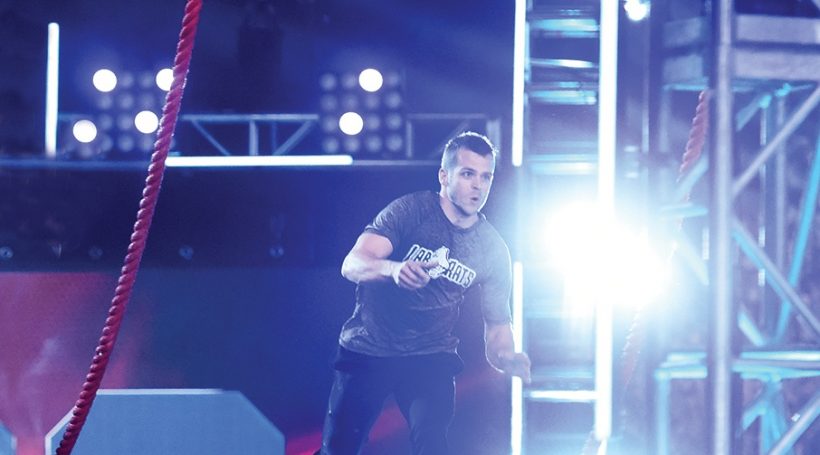Photo by Eddy Chen/USA Network
When Chris and Brian Wilczewski were in high school, they spent a lot of time in their Mount Laurel backyard, climbing, jumping and swinging on the obstacle course they’d built, inspired by a Japanese TV show they loved.
Flash forward a decade or so, and Brian (the mastermind of the backyard playground) is an engineer at Boeing. Chris, 29, owns a gym in Hainesport. And they both still run the occasional obstacle course, only now the obstacles – and the crowds – are way bigger, there’s a whole lot of money on the line, and the whole shebang is on national television.
The brothers are veteran competitors on NBC’s “American Ninja Warrior” – an intensely physical sport that requires elite athletes to jump, swing, climb and swim their way through progressively more difficult obstacles in pursuit of a million-dollar prize. In the 10 years the show’s been on the air, only two competitors have ever beaten every obstacle. But more than 3,500 have tried, and a disproportionate number of them have come from New Jersey.
“New Jersey has been ground zero,” Chris says.
“When my brother and I started the Warrior Lab, it was the first dedicated ninja warrior training facility in the country. From there, it was like a ripple effect. Guys who used to train with us have been opening their own gyms. People who came and started with us connected with it and branched off and did their own thing. Now there are gyms popping up all over the country.”
Chris has been competing on the American Ninja Warrior TV show, which airs on NBC, since its second season. This year, he made it all the way to the national finals in Las Vegas – and he wasn’t alone. He was joined by Cherry Hill native Jamie Rahn, Gloucester County’s Judas Licciardello, and Rachel Goldstein, an occupational therapist at Kingsway Learning Center in Moorestown.
“I watched the show when I was living in Harrisburg, and I always loved it,” Goldstein says. “You’d see clips of the competitors practicing at these gyms, and they were all in New Jersey. When I moved here for my husband’s job, I started going to the gym, but I was just going for fun. My goal was never to be on TV or anything like that.”
But today, Goldstein is one of the show’s most notable competitors. She made history in season eight when she was one of four women to land in the top 30. They were dubbed “The Fantastic Four.”
“It’s given me so much confidence,” she says. “When I watched this on TV, I wasn’t even putting that much effort into working out. To have gone from that to doing this on a competitive level has given me confidence that with hard work and dedication, anyone can accomplish anything.”
Goldstein works out at Wilczewski’s gym in Hainesport, now called the Movement Lab. She also visits Cherry Hill’s Pinnacle Parkour Academy and other dedicated ninja gyms in the area. Despite owning his own training facility, Chris does the same. Working out in different gyms, they agree, is the best way to make sure you’re ready for anything.
“You don’t know what obstacles are going to be waiting for you in the competition, and you can’t practice anything beforehand,” Goldstein explains.
“You can try to watch other people go and try to come up with your own plan, but what works for one person might not work for you, depending on your height and weight. It’s helpful to just always keep your workout different and try new things. Then you can say, ‘Ok, this is similar to this other thing I’ve done in the past.’ I know my grip strength and how long my forearms should last, and that gives you a good sense of what to do. Sometimes there are things you don’t anticipate, and then it doesn’t work out the way you wanted.”
By that, Goldstein means you fall. During your competition run, if you miss a grab or a landing, misjudge a leap, lose your grip, or just plain get too tired, you’ll fall – sometimes somersaulting – into the pool of water below.
However impressive the giant obstacles might look on TV, Wilczewski says they’re even bigger in person.
“I feel like with a lot of the obstacles and the size of the movements the athletes are doing, when you watch it on TV everything gets kind of crunched up,” he says. “But when you’re there in person, staring at an 18-foot warped wall, and people are running up it, it’s kind of awe-inspiring. We have people come in the gym and go, ‘Wait, that’s the wall?’ It’s so much bigger than they think it’s going to be.”
Goldstein says the pressure has mounted as she’s gotten more serious about the competitive side of her hobby, “but at the same time, I’ve tried to make a conscious effort to have fun. I’m doing it because I like to do it. I’m doing it for the right reasons, not because I feel like I have to, because then it’s not fun anymore. I go to ninja gyms because it’s like being on a playground.”
And while it is a competition – again, anyone who can go all the way leaves with $1 million – it’s also a tight-knit, supportive community.
“The atmosphere and camaraderie between everyone is unique,” Goldstein says. “Everyone is always cheering for each other. We have each other’s backs. Everyone is so supportive, no matter what level you’re at. When you’re at the gym, a lot of people are new, they’re not on the show and they have fitness goals of their own, but everyone will still be cheering for them.”
Wilczewski says a lot of that camaraderie comes from the fact that what they’re out there doing is really, really hard.
“The sport is extremely humbling,” he says. “You can be the best athlete in the world and you still have to accept that nobody is going to do everything perfectly. Everyone that’s doing this has been humbled. We know how long it takes, so we ban together and pick each other up. When you see us cheering for each other on TV, that’s extremely genuine. We don’t care who it is, we just want somebody to beat it all. It feels like it’s us against the course.”
About 1,000 people submitted applications to compete on the first season of American Ninja Warrior. This season, there were more than 70,000 hopefuls. Wilczewski expects the sport to continue its rapid growth.
“I feel like it has so much potential,” he says. “Between the leagues that are popping up, the youth involvement and the explosion of gyms across the country, this could be the next big thing.”
The best part is you don’t need expensive equipment or a fancy gym to start training: “Really, you can just go to a playground and work on climbing,” he says. “It’s all body weight calisthenics.”
Or, of course, you could build your own backyard obstacles. If you put the results on YouTube, there’s a good chance Wilczewski will be watching.
“I do watch a lot of the videos these kids post, and I try to like or comment when I see something really cool,” he laughs. “One day that kid who built the warped wall in the backyard is going to be kicking my butt on the big course.”














